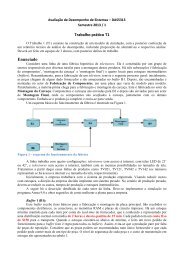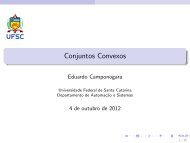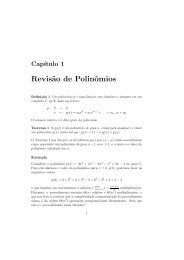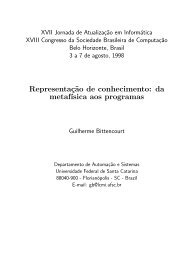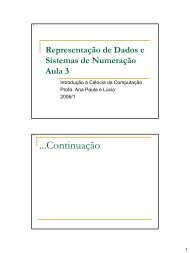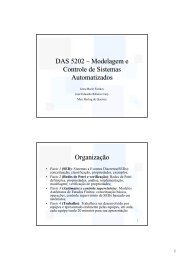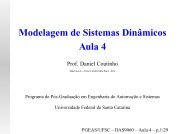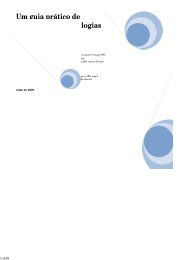Elastic Task Model For Adaptive Rate Control
Elastic Task Model For Adaptive Rate Control
Elastic Task Model For Adaptive Rate Control
Create successful ePaper yourself
Turn your PDF publications into a flip-book with our unique Google optimized e-Paper software.
Proceedings of the IEEE Real-Time Systems Symposium, Madrid, Spain, December 1998. 1<br />
<strong>Elastic</strong> <strong>Task</strong> <strong>Model</strong> <strong>For</strong> <strong>Adaptive</strong> <strong>Rate</strong> <strong>Control</strong><br />
Giorgio C. Buttazzo, Giuseppe Lipari, and Luca Abeni<br />
Scuola Superiore S. Anna, Pisa, Italy<br />
giorgio,lipari¡ @sssup.it, luca@hartik.sssup.it<br />
Abstract<br />
An increasing number of real-time applications, related<br />
to multimedia and adaptive control systems, require greater<br />
flexibility than classical real-time theory usually permits.<br />
In this paper we present a novel periodic task model, in<br />
which tasks’ periods are treated as springs, with given elastic<br />
coefficients. Under this framework, periodic tasks can<br />
intentionally change their execution rate to provide different<br />
quality of service, and the other tasks can automatically<br />
adapt their periods to keep the system underloaded. The<br />
proposed model can also be used to handle overload conditions<br />
in a more flexible way, and provide a simple and<br />
efficient mechanism for controlling the quality of service of<br />
the system as a function of the current load.<br />
1. Introduction<br />
Periodic activities represent the major computational demand<br />
in many real-time applications, since they provide a<br />
simple way to enforce timing constraints through rate control.<br />
<strong>For</strong> instance, in digital control systems, periodic tasks<br />
are associated with sensory data acquisition, low-level servoing,<br />
control loops, action planning, and system monitoring.<br />
In such applications, a necessary condition for guaranteeing<br />
the stability of the controlled system is that each<br />
periodic task is executed at a constant rate, whose value is<br />
computed at the design stage based on the characteristics of<br />
the environment and on the required performance. <strong>For</strong> critical<br />
control applications (i.e., those whose failure may cause<br />
catastrophic consequences), the feasibility of the schedule<br />
has to be guaranteed a priori and no task can change its<br />
period while the system is running.<br />
Such a rigid framework in which periodic tasks operate is<br />
also determined by the schedulability analysis that must be<br />
performed on the task set to guarantee its feasibility under<br />
the imposed constraints. To simplify the analysis, in fact,<br />
some feasibility tests for periodic tasks are based on quite<br />
rigid assumptions. <strong>For</strong> example, in the original Liu and<br />
Layland’s paper [7] on the <strong>Rate</strong> Monotonic (RM) and the<br />
Earliest Deadline First (EDF) algorithms, a periodic ¢¤£ task<br />
is modeled as a cyclical processor activity characterized by<br />
two parameters, the computation ¥ £ time and period¦ £ the ,<br />
which are considered to be constant for all task instances.<br />
This is a reasonable assumption for most real-time control<br />
systems, but it can be too restrictive for other applications.<br />
<strong>For</strong> example, in multimedia systems timing constraints<br />
can be more flexible and dynamic than control theory usually<br />
permits. Activities such as voice sampling, image acquisition,<br />
sound generation, data compression, and video playing,<br />
are performed periodically, but their execution rates are<br />
not as rigid as in control applications. Missing a deadline<br />
while displaying an MPEG video may decrease the quality<br />
of service (QoS), but does not cause critical system faults.<br />
Depending on the requested QoS, tasks may increase or decrease<br />
their execution rate to accommodate the requirements<br />
of other concurrent activities.<br />
If a multimedia task manages compressed frames, the<br />
time for coding/decoding each frame can vary significantly,<br />
hence the worst-case execution time (WCET) of the task can<br />
be much bigger than its mean execution time. Since hard<br />
real-time tasks are guaranteed based on their WCET (and<br />
not based on mean execution times), multimedia activities<br />
can cause a waste of the CPU resource, if treated as “rigid”<br />
hard real-time tasks.<br />
In order to provide theoretical support for such applications,<br />
some work has been done to deal with tasks with<br />
variable computation times. In [18] a probabilistic guarantee<br />
is performed on tasks whose execution times have known<br />
distribution. In [17], the authors provide an upper bound<br />
of completion times of jobs chains with variable execution<br />
times and arbitrary release times. In [9], a guarantee is<br />
computed for tasks whose jobs are characterized by variable<br />
computation times and interarrival times, occurring with a<br />
cyclical pattern. In [8], a capacity reservation technique<br />
is used to handle tasks with variable computation time and<br />
bound their computational demand.<br />
Even in some control application, there are situations in<br />
which periodic tasks could be executed at different rates in<br />
different operating conditions. <strong>For</strong> example, in a flight control<br />
system, the sampling rate of the altimeters is a function
Proceedings of the IEEE Real-Time Systems Symposium, Madrid, Spain, December 1998. 2<br />
of the current altitude of the aircraft: the lower the altitude,<br />
the higher the sampling frequency. A similar need arises<br />
in robotic applications in which robots have to work in unknown<br />
environments where trajectories are planned based<br />
on the current sensory information. If a robot is equipped<br />
with proximity sensors, in order to maintain a desired performance,<br />
the acquisition rate of the sensors must increase<br />
whenever the robot is approaching an obstacle.<br />
In other situations, the possibility of varying tasks’ rates<br />
increases the flexibility of the system in handling overload<br />
conditions, providing a more general admission control<br />
mechanism. <strong>For</strong> example, whenever a new task cannot be<br />
guaranteed by the system, instead of rejecting the task, the<br />
system can try to reduce the utilizations of the other tasks (by<br />
increasing their periods in a controlled fashion) to decrease<br />
the total load and accommodate the new request. Unfortunately,<br />
there is no uniform approach for dealing with these<br />
situations. <strong>For</strong> example, Kuo and Mok [4] propose a load<br />
scaling technique to gracefully degrade the workload of a<br />
system by adjusting the periods of processes. In this work,<br />
tasks are assumed to be equally important and the objective<br />
is to minimize the number of fundamental frequencies to<br />
improve schedulability under static priority assignments. In<br />
[12], Nakajima and Tezuka show how a real-time system<br />
can be used to support an adaptive application: whenever<br />
a deadline miss is detected, the period of the failed task is<br />
increased. In [13], Seto et al. change tasks’ periods within<br />
a specified range to minimize a performance index defined<br />
over the task set. This approach is effective at a design<br />
stage to optimize the performance of a discrete control system,<br />
but cannot be used for on-line load adjustment. In [6],<br />
Lee, Rajkumar and Mercer propose a number of policies to<br />
dynamically adjust the tasks’ rates in overload conditions.<br />
In [1], Abdelzaher, Atkins, and Shin present a model for QoS<br />
negotiation to meet both predictability and graceful degradation<br />
requirements in cases of overload. In this model, the<br />
QoS is specified as a set of negotiation options, in terms<br />
of rewards and rejection penalties. In [10, 11], Nakajima<br />
shows how a multimedia activity can adapt its requirements<br />
during transient overloads by scaling down its rate or its<br />
computational demand. However, it is not clear how the the<br />
QoS can be increased when the system is underloaded.<br />
Although these approaches may lead to interesting results<br />
in specific applications, we believe that a more general<br />
framework can be used to avoid a proliferation of policies<br />
and treat different applications in a uniform fashion.<br />
In this paper we present a novel framework, the elastic<br />
model, which has the following advantages:<br />
it allows tasks to intentionally change their execution<br />
rate to provide different quality of service;<br />
it can handle overload situations in a more flexible<br />
way;<br />
it provides a simple and efficient method for controlling<br />
the quality of service of the system as a function<br />
of the current load.<br />
The rest of the paper is organized as follows. Section<br />
2 presents the elastic task model. Section 3 illustrates the<br />
equivalence of the model with a mechanical system of linear<br />
springs. Section 4 describes the guarantee algorithm for a set<br />
of elastic tasks. Section 5 presents some theoretical results<br />
which validate the proposed model. Section 6 illustrates<br />
some experimental results achieved on the HARTIK kernel.<br />
Finally, Section 7 contains our conclusions and future work.<br />
2. The elastic model<br />
The basic idea behind the elastic model proposed in this<br />
paper is to consider each task as flexible as a spring with a<br />
given rigidity coefficient and length constraints. In particular,<br />
the utilization of a task is treated as an elastic parameter,<br />
whose value can be modified by changing the period or<br />
the computation time. To simplify the presentation of the<br />
model, in this paper we assume that the computation is fixed,<br />
while the period can be varied within a specified range.<br />
Each task is characterized by five parameters: a computation<br />
¥ £ time , a nominal ¦ £ period 0, a minimum period<br />
£¢¡¤£¢¥ , a maximum period ¦ £¦¡¨§© , and an elastic coefficient<br />
<br />
¦<br />
<br />
0, which specifies the flexibility of the task to vary its<br />
£<br />
utilization for adapting the system to a new feasible rate configuration.<br />
The greater £ , the more elastic the task. Thus,<br />
an elastic task is denoted as:<br />
<br />
£ ¥ £ ¦ £<br />
0 ¦ £¦¡¤£¥ ¦ £¦¡¨§© <br />
£<br />
¢<br />
In the following, ¦ £ will denote the actual period of task<br />
¢ £ , which is constrained to be in the range ¦ £ ¡¤£¥ ¦ £ ¡¨§© .<br />
Any task can vary its period according to its needs within<br />
the specified range. Any variation, however, is subject to<br />
an elastic guarantee and is accepted only if there exists a<br />
feasible schedule in which all the other periods are within<br />
their range. Consider, for example, a set of three tasks,<br />
whose parameters are shown in Table 1. With the nominal<br />
periods, the task set is schedulable by EDF since<br />
10 10 15<br />
20 40 70<br />
0 964 <br />
If task ¢ 3 reduces its period to 50, no feasible schedule<br />
exists, since the utilization would be greater than 1:<br />
10<br />
20<br />
10<br />
40<br />
15<br />
50<br />
1 05<br />
However, notice that a feasible schedule exists ( 0 977)<br />
for !" 1 22, ¦ 2 45, and ¦ 3 50, hence the system can<br />
¦<br />
accept the higher request rate ¢ of 3 by slightly decreasing<br />
1<br />
1
Proceedings of the IEEE Real-Time Systems Symposium, Madrid, Spain, December 1998. 3<br />
¥ £ ¦ £ <strong>Task</strong> ¦<br />
0<br />
£ ¡¤£¥ ¦ £ ¡¨§ ©<br />
¢<br />
¢<br />
1 10 20 20 25 1<br />
2 10 40 40 50 1<br />
¢ 3 15 70 35 80 1<br />
Table 1. <strong>Task</strong> set parameters used for the example.<br />
the rates of ¢ 1 and ¢ 2. <strong>Task</strong> ¢ 3 can even run with a period<br />
3 40, since a feasible schedule exists with periods ¦ 1<br />
¦<br />
¦ and 2 within their range. In when¦ fact, 1 ¦ 24, 2 50,<br />
3 40, 0 992. Finally, notice that if ¢ 3 requires<br />
and¦<br />
to run with a ¦ period 3 35, there is no feasible schedule<br />
periods¦ with and¦ 1 2 within their range, hence the request<br />
3 to execute with a period¦ 3 35 must be rejected.<br />
of¢<br />
Clearly, for a given value of¦ 3, there can be many different<br />
period configurations which lead to a feasible schedule,<br />
hence one of the possible feasible configurations must be<br />
selected. The great advantage of using an elastic model is<br />
that the policy for selecting a solution is implicitly encoded<br />
in the elastic coefficients provided by the user. Thus, each<br />
task is varied based on its current elastic status and a feasible<br />
configuration is found, if there exists one.<br />
As another example, consider the same set of three tasks<br />
with their nominal periods, but suppose that a new periodic<br />
task ¢ 4 5 30 30 30 0 enters the system at time ¡ . In a<br />
rigid scheduling framework,¢ 4 (or some other task selected<br />
by a more sophisticated rejection policy) must be rejected,<br />
because the new task set is not schedulable, being<br />
<br />
4<br />
¢<br />
1 £¤£<br />
£ ¥<br />
£<br />
0<br />
¦<br />
1 131<br />
Using an elastic model, ¢ however, 4 can be accepted if<br />
the periods of the other tasks can be increased in such a<br />
way that the total utilization is less than one and all the<br />
periods are within their range. In our specific example, the<br />
period configuration given ¦ by 1 ¦ 23, 2 ¦ 50, 3 80,<br />
4 30, creates a total utilization 0 989, hence ¢ 4<br />
¦<br />
can be accepted.<br />
The elastic model also works in the other direction.<br />
Whenever a periodic task terminates or decreases its rate,<br />
all the tasks that have been previously “compressed” can<br />
increase their utilization or even return to their nominal periods,<br />
depending on the amount of released bandwidth.<br />
It is worth to observe that the elastic model is more general<br />
than the classic Liu and Layland’s task model, so it<br />
does not prevent a user from defining hard real-time tasks.<br />
In fact, a having¦ £¢¡¤£¢¥ ¦ £¦¡¨§©<br />
task is equivalent to<br />
a hard real-time task with fixed period, independently of its<br />
¦ £<br />
0<br />
1<br />
<br />
£<br />
elastic coefficient. A task with £<br />
<br />
0 can arbitrarily vary<br />
its period within its specified range, but it cannot be varied<br />
<br />
by the system during load reconfiguration.<br />
3. Equivalence with a spring system<br />
To understand how an elastic guarantee is performed in<br />
this model, it is convenient to compare an elastic ¢ £ task<br />
with a spring¥ £ linear characterized by a rigidity<br />
¦<br />
coefficient<br />
, a nominal length § £ 0, a minimum length § £¦¡¤£¥ and a<br />
£<br />
length§ £¦¡¨§ © maximum . In following,§ £ the will denote the<br />
actual length of ¥ £ spring , which is constrained to be in the<br />
§ £¢¡¨£¥ ¨§ £¦¡¨§ © range .<br />
In this comparison, the § £ length of the spring is equivalent<br />
to the task’s utilization factor £<br />
<br />
¥ £© ¦ £ , and the<br />
rigidity coefficient £ is equivalent to the inverse of task’s<br />
elasticity ( ¦ £<br />
<br />
1©<br />
<br />
£ ). Hence, a set of tasks with total utilization<br />
factor ¦ £¤£ 1<br />
£ can be viewed as a sequence<br />
of springs with total length <br />
1§ £ ££ .<br />
Using the same notation introduced by Liu and Layland<br />
[7], let ¤ be the least upper bound of the total utilization<br />
factor for a given scheduling algorithm (we recall that for<br />
<br />
tasks <br />
<br />
! 2 1 <br />
1 and "!$#&% ¤ 1). Hence,<br />
<br />
a task set can be schedulable by if<br />
(' " . Under<br />
EDF, such a schedulability condition becomes necessary and<br />
<br />
sufficient.<br />
Under the elastic model, given a algorithm<br />
scheduling<br />
and a set of tasks with " ¤ , the objective of the<br />
guarantee is to compress tasks’ utilization factors in order to<br />
<br />
achieve a new utilization<br />
' " such that all the periods<br />
)<br />
are within their ranges. In the linear spring system, this is<br />
equivalent of compressing the springs so that the new total<br />
length )<br />
is less than or equal to a given maximum length<br />
+*-,/. . More formally, in the spring system the problem can<br />
be stated as follows.<br />
Given a set of springs with known rigidity<br />
and length constraints, if 01*-,/. , find a set<br />
of new lengths§<br />
) £ such that§<br />
) £32 § £ ¡¤£¢¥ 4§ £ ¡ § © <br />
) <br />
65 , where75 is any arbitrary desired<br />
and<br />
length such 15 0+*-,/. that .<br />
<strong>For</strong> the sake of clarity, we first solve the problem for a spring<br />
system without length constraints, then we show how the<br />
solution can be modified by introducing length constraints,<br />
and finally we show how the solution can be adapted to the<br />
case of a task set.<br />
3.1 Springs with no length constraints<br />
Consider a set Γ of springs with nominal § £ length<br />
0<br />
and rigidity coefficient £ positioned one after the other, as<br />
depicted in Figure 1. Let 0 be the total length of the array,<br />
that is the sum of the nominal lengths: ¦ 0<br />
89 £¤£ 1§ £ 0. If
¤<br />
¢<br />
¢ <br />
¤<br />
¤<br />
§<br />
¤<br />
§<br />
Proceedings of the IEEE Real-Time Systems Symposium, Madrid, Spain, December 1998. 4<br />
x 10<br />
x 20<br />
x 30<br />
x 40<br />
k 1 k 2 k 3 k 4<br />
L max<br />
L 0<br />
L<br />
x 1 x 2 x 3 x 4<br />
k 1<br />
k 2<br />
k 3<br />
k 4<br />
L’<br />
L max<br />
F<br />
L 0<br />
L<br />
Figure 1. A linear spring system: the total length is 0 when springs are uncompressed (a); and<br />
0 when springs are compressed (b).<br />
<br />
the array is compressed so that its total length is equal to a<br />
0), the first problem we want<br />
<br />
length 5 desired 0 5 (0<br />
to solve is to find the length§ £ new of each spring, assuming<br />
that for all , 0 § £ § £ 0. Being 75 the total length of the<br />
compressed array of springs, we have:<br />
¡<br />
§ £ (1)<br />
equations (3) and (4) to the set Γ§ of variable springs, we<br />
have<br />
where<br />
¥ £ 2<br />
£<br />
§ £<br />
<br />
§ £<br />
0<br />
<br />
0 65<br />
<br />
¦ <br />
Γ§<br />
¦ £<br />
(5)<br />
§ £¦¡¤£¥ (6)<br />
5<br />
<br />
££ 1<br />
¢ <br />
£ Γ ©<br />
If ¢ is the force that keeps a spring in its compressed state,<br />
then, for the equilibrium of the system, it must be:<br />
£ ¡<br />
¦ £<br />
<br />
§ £<br />
0<br />
§ £ (2)<br />
<br />
Solving the equations (1) and (2) for the unknown § 1, § 2,<br />
, § , we have:<br />
where<br />
¡<br />
§ £<br />
<br />
§ £<br />
£ <br />
<br />
0 0 5 <br />
<br />
<br />
1<br />
3.2 Introducing length constraints<br />
£¤£ 1 1 ¥<br />
£<br />
¦ <br />
(3)<br />
£<br />
(4)<br />
If each spring has a length constraint, in the sense that its<br />
length cannot be less than a minimum value§ £¢¡¨£¥ , then the<br />
problem of finding the values § £ requires an iterative solution.<br />
In fact, if during compression one or more springs<br />
reach their minimum length, the additional compression<br />
force will only deform the remaining springs. Thus, at<br />
each instant, the set Γ can be divided into two subsets: a set<br />
of fixed springs having minimum length, and a set Γ§<br />
Γ¦<br />
of variable springs that can still be compressed. Applying<br />
1<br />
<br />
<br />
£ Γ ©<br />
¥ 1<br />
£<br />
(7)<br />
Whenever there exists some spring for which equation (5)<br />
gives § £ § £ ¡¤£¥ , the length of that spring has to be fixed<br />
at its minimum value, sets Γ¦ and Γ§ must be updated, and<br />
equations (5), (6) and (7) recomputed for the new set Γ§ . If<br />
there exists a feasible solution, that is, if the desired final<br />
length 5 is greater than or equal to the minimum possible<br />
length of the array * £ <br />
££ 1§ £¦¡¤£¥ , the iterative<br />
process ends when each value computed by equations (5) is<br />
greater than or equal to its corresponding minimum § £¦¡¤£¥ .<br />
The complete algorithm for compressing a set Γ of springs<br />
with length constraints up to a desired length -5 is shown<br />
in Figure 2.<br />
4. Compressing tasks’ utilizations<br />
When dealing with a set of elastic tasks, equations (5),<br />
(6) and (7) can be rewritten by substituting all length parameters<br />
with the corresponding utilization factors, and the<br />
rigidity £ coefficients and § with the corresponding elastic<br />
coefficients ¤ and § . Similarly, at each instant, the set<br />
£<br />
Γ of periodic tasks can be divided into two subsets: a ¦ Γ¦ set<br />
of fixed tasks having minimum utilization, and Γ§ a set of<br />
variable tasks that can still be compressed. £<br />
<br />
If ¥ £© ¦ £<br />
0<br />
0<br />
<br />
¨¦
£<br />
¤<br />
£<br />
§<br />
<br />
£<br />
<br />
¦<br />
<br />
<br />
¤<br />
<br />
£<br />
<br />
<br />
£<br />
£<br />
¦<br />
<br />
<br />
£<br />
<br />
<br />
£<br />
¦<br />
<br />
<br />
<br />
¦<br />
<br />
£<br />
Proceedings of the IEEE Real-Time Systems Symposium, Madrid, Spain, December 1998. 5<br />
Algorithm Spring compress(Γ, 15 )<br />
0<br />
££ 1§ £ 0;<br />
* £ £¤£ 1§ £¢¡¤£¢¥ ; <br />
( 5 * £ if ) return INFEASIBLE;<br />
do<br />
Algorithm <strong>Task</strong> compress(Γ, 5 )<br />
<br />
0 1¥ £ ©¤¦ £ £¤£<br />
<br />
* £ <br />
9 0;<br />
£¤£ ¥ £ ©¤¦ £¢¡¨§© 1<br />
;<br />
if ( <br />
do<br />
5 <br />
* £ ) return INFEASIBLE;<br />
Γ¦ = ¥ £¢¡§ £<br />
<br />
§ £¦¡¤£¥¤£ ;<br />
Γ§<br />
Γ Γ¦ ;<br />
§<br />
0;<br />
for ( ¢ £ )<br />
if (( £<br />
<br />
0) or (¦ £<br />
<br />
¦ £ ¡ § © ))<br />
©<br />
£ Γ § £ ¡¤£¥ ;<br />
<br />
£ ;<br />
1 <br />
¦¥<br />
£¨§ Γ 1 ¥<br />
£<br />
;<br />
else §<br />
<br />
£ ;<br />
¦<br />
© ¦ <br />
1;<br />
for ( ¥ £ 2 Γ§ )<br />
<br />
£<br />
<br />
§ £<br />
0<br />
<br />
0 5<br />
<br />
¦ <br />
§<br />
(§ £ § £¦¡¤£¥ if )<br />
£<br />
<br />
§ £¢¡¤£¢¥ ;<br />
© ¦ <br />
§<br />
0;<br />
§ © ¦ £ ;<br />
© ¦ <br />
1;<br />
for ( ¢ £ 2 Γ§ )<br />
if (( <br />
0) and (¦ £ ¦ £¦¡¨§ © )) £<br />
£<br />
<br />
£<br />
<br />
0<br />
£<br />
<br />
¥ £©<br />
<br />
£ ; ¦<br />
(¦ £ ¦ £¢¡ § © if )<br />
£<br />
<br />
¦ £¦¡¨§ © ;<br />
© ¦ <br />
¦<br />
0;<br />
<br />
0 <br />
5<br />
<br />
¦ <br />
<br />
£ © § ;<br />
while ( © ¦ <br />
0);<br />
£<br />
return FEASIBLE;<br />
§<br />
while ( © ¦ <br />
0);<br />
£<br />
return FEASIBLE;<br />
Figure 2. Algorithm for compressing a set of<br />
springs with length constraints.<br />
is the nominal utilization of task ¢ £ , <br />
0 is the sum of all the<br />
nominal utilizations, and ¦ is the total utilization factor of<br />
tasks in <br />
, then to achieve a desired utilization <br />
5 0<br />
Γ¦<br />
each task has to be compressed up to the following utilization:<br />
where<br />
£<br />
¢ £ 2 Γ§<br />
£<br />
<br />
£<br />
<br />
0<br />
<br />
¢ <br />
£ Γ <br />
¢ <br />
£ Γ <br />
0 <br />
5<br />
<br />
¦ <br />
£<br />
<br />
§ <br />
(8)<br />
<br />
£¢¡¨£¥ (9)<br />
<br />
£ (10)<br />
Figure 3. Algorithm for compressing a set of<br />
elastic tasks.<br />
again to the tasks Γ§ in . If there exists a feasible solution,<br />
that is, if the desired utilization 5 is greater than or equal<br />
to the minimum possible utilization <br />
* £ <br />
££ <br />
<br />
£ ¡ § © 1<br />
,<br />
the iterative process ends when each value computed by<br />
equation (8) is greater than or equal to its corresponding<br />
minimum £ ¡¤£¢¥ . The algorithm 1 for compressing a set Γ<br />
of <br />
elastic tasks up to a desired utilization <br />
5 is shown in<br />
<br />
Figure 3.<br />
4.1 Decompression<br />
§<br />
If there exist tasks for which <br />
of those tasks has to be fixed at its maximum value ¦ £ ¡ § ©<br />
(so that £<br />
<br />
£¦¡¤£¥ ), sets Γ¦ and Γ§ must be updated<br />
(hence, ¦ and § recomputed), and equation (8) applied<br />
<br />
£ <br />
£ ¡¤£¢¥ , then the period<br />
All tasks’ utilizations that have been compressed to cope<br />
with an overload situation can return toward their nominal<br />
1 The actual implementation of the algorithm contains more checks on<br />
tasks’ variables, which are not shown here to simplify its description.
§<br />
§<br />
§<br />
<br />
<br />
§<br />
¢<br />
<br />
<br />
<br />
<br />
<br />
£<br />
<br />
<br />
<br />
¢ <br />
£<br />
£<br />
<br />
<br />
<br />
'<br />
¥<br />
¢<br />
<br />
£<br />
<br />
¡<br />
<br />
£<br />
¥ £ ¢<br />
£<br />
¡<br />
<br />
¦<br />
<br />
¢<br />
¢<br />
¢<br />
¢<br />
<br />
<br />
<br />
<br />
¡<br />
<br />
<br />
¡<br />
<br />
<br />
<br />
<br />
Proceedings of the IEEE Real-Time Systems Symposium, Madrid, Spain, December 1998. 6<br />
values when the overload is over. Let Γ be the subset of<br />
compressed tasks (that is, the set of tasks with ¦ £ ¦ £ 0),<br />
Γ, let be the set of remaining tasks in Γ (that is, the set of<br />
be the current processor<br />
5<br />
tasks ¦ £ ' ¦ £ with 0), and let<br />
utilization of Γ. Whenever a task in <br />
decreases its rate or<br />
Γ,<br />
returns to its nominal period, all tasks in Γ can expand their<br />
utilizations according to their elastic coefficients, so that the<br />
processor utilization is kept at the value of 5 .<br />
<br />
Now, let be the total utilization of Γ , , let be the<br />
total utilization of , and let<br />
0<br />
be the total utilization Γ, of<br />
tasks in Γ at their nominal periods. It can easily be <br />
seen<br />
<br />
that , ' <br />
if<br />
0<br />
all tasks in Γ can return to their<br />
nominal periods. On the other <br />
hand, ,<br />
<br />
¤ if<br />
0<br />
,<br />
then the release operation of the tasks in Γ can be viewed<br />
as Γ¦ Γ, a Γ§<br />
compression, where and Γ . Hence, it<br />
can still be performed by using equations (8), (9) and (10)<br />
and the algorithm presented in Figure 3.<br />
Lemma 2 In any feasible EDF schedule ¡ , the following<br />
condition holds:<br />
£ ¡<br />
0<br />
<br />
£ <br />
¡<br />
<br />
1 £¤£<br />
'<br />
<br />
¢<br />
¤£ <br />
¡<br />
<br />
1 ££<br />
¡ £ <br />
<br />
<br />
¥ £ © ¦ £ where , £ <br />
¡<br />
is the remaining execution time of<br />
£<br />
the current instance of at time , and £ <br />
¡<br />
is the next<br />
task¢ £<br />
of¢ £ release time greater than or equal ¡ to t.<br />
Proof.<br />
By definition of £ <br />
¡<br />
, we have<br />
<br />
£ <br />
¡<br />
<br />
<br />
¡<br />
5. Theoretical validation of the model<br />
£ <br />
¡<br />
<br />
and, by Lemma 1,<br />
In this section we derive some theoretical results which<br />
validate the elastic guarantee algorithm that can be performed<br />
with this method. In particular, we show that if<br />
tasks’ periods are changed at opportune instants the task set<br />
remains schedulable and no deadline is missed. The following<br />
lemmas state two properties of the EDF algorithm that<br />
are useful for proving the main theorem.<br />
<br />
£ <br />
¡<br />
<br />
1 ££<br />
£¤£ 1 <br />
£¤£ 1 <br />
¦ £ <br />
¦ £<br />
¡<br />
<br />
£ <br />
¥ £ ¢<br />
£ <br />
¡<br />
<br />
'<br />
¦<br />
¡<br />
<br />
£<br />
¥ £ ¡ <br />
£ <br />
¦<br />
Lemma 1 In any feasible EDF schedule ¡ , the following<br />
condition holds:<br />
£¤£ 1 <br />
£<br />
<br />
¡<br />
¦ £ <br />
¦<br />
£<br />
<br />
£ ¡<br />
0<br />
£¤£ 1<br />
£<br />
££ 1<br />
£<br />
¡<br />
<br />
¢<br />
<br />
¡<br />
¤£ <br />
¡<br />
<br />
where 9 ££ 1<br />
¥ £ © ¦ £ and ¢ £ <br />
¡<br />
is the cumulative time<br />
executed by all the instances of task¢ £ up to ¡ .<br />
Proof.<br />
If ¡ <br />
¡<br />
<br />
¤£¦¥<br />
¢ ££ 1<br />
£ <br />
¡<br />
<br />
<br />
<br />
¡<br />
<br />
¨ , we have that<br />
<br />
¨©<br />
££ £ ¥ £ <br />
<br />
1<br />
¡<br />
£<br />
<br />
¡<br />
The following theorem states a property of decompression:<br />
if at time all the periods are increased from ¦ £ to<br />
¦ )<br />
¡<br />
, then the total utilization factor is decreased from to<br />
) £<br />
<br />
<br />
£ ££ 1<br />
.<br />
Theorem 1 Given a feasible task set Γ, with total utilization<br />
factor 1<br />
<br />
'<br />
1, if at time all the periods are<br />
¡ <br />
¦<br />
££<br />
to¦<br />
) £<br />
<br />
¦ £<br />
<br />
increased from , then for £ £ all 0,<br />
¡ <br />
££ 1 <br />
<br />
¡<br />
<br />
If ¡ <br />
¡<br />
<br />
¤£¦¥<br />
¨ :<br />
<br />
¡ <br />
1<br />
1<br />
1<br />
1<br />
¢ £¤£ 1<br />
£ <br />
¡ <br />
<br />
<br />
¡<br />
<br />
¡ <br />
¡ <br />
¡ <br />
1<br />
§<br />
¢ £¤£ 1<br />
£ <br />
¡<br />
<br />
<br />
<br />
<br />
¡<br />
<br />
1 §<br />
1<br />
¡<br />
¡<br />
<br />
¡<br />
<br />
<br />
1<br />
1<br />
§<br />
£¦¥<br />
Moreover, 0 being and 1 1 (because<br />
the system is feasible), we have that, for all 0,<br />
§<br />
<br />
. ¡ ¡ <br />
<br />
¡<br />
<br />
¡<br />
<br />
¡ <br />
<br />
' <br />
) <br />
<br />
where <br />
¡<br />
1 <br />
¡<br />
2 is the total processor demand of Γ in ¡<br />
1 <br />
¡<br />
2 ,<br />
<br />
¥ <br />
and ")<br />
<br />
£<br />
.<br />
1 £¤£<br />
Proof.<br />
As task periods are increased at time , the new release time<br />
of task¢ £ is:<br />
¡<br />
<br />
<br />
¡<br />
<br />
)<br />
£ <br />
¡<br />
<br />
<br />
¡<br />
<br />
¦ £<br />
<br />
¦ )<br />
£ <br />
¤£
¥<br />
<br />
<br />
'<br />
'<br />
¢<br />
¢<br />
¢<br />
¢<br />
¢<br />
<br />
<br />
<br />
<br />
<br />
<br />
¢<br />
¢<br />
<br />
¢ <br />
¡<br />
¥ £<br />
<br />
£<br />
¡<br />
¥ £<br />
<br />
¢<br />
£<br />
<br />
£ <br />
<br />
)<br />
¥<br />
£<br />
<br />
¢<br />
<br />
<br />
£<br />
¢ <br />
<br />
<br />
<br />
<br />
'<br />
<br />
£<br />
<br />
<br />
<br />
<br />
Proceedings of the IEEE Real-Time Systems Symposium, Madrid, Spain, December 1998. 7<br />
τ 1<br />
ν 1<br />
ν 1<br />
’<br />
ν<br />
2<br />
τ 2<br />
ν ’ 2<br />
3<br />
ν 3<br />
ν ’<br />
τ 3<br />
t<br />
Figure 4. Example of tasks that simultaneously increase their periods at time ¡ .<br />
The total demand ¡<br />
<br />
¡ <br />
in is given by the total execution<br />
time of the instances released after or at with deadlines less<br />
than or equal to ¡ , plus the remaining execution times<br />
of the current active instances. The situation considered in<br />
the proof is illustrated in Figure 4.<br />
¡<br />
Using the result of Lemma 2 we can write:<br />
<br />
¡<br />
<br />
¡ <br />
££ 1<br />
<br />
¡ <br />
<br />
<br />
) £ <br />
¡<br />
<br />
¦ )<br />
¡<br />
£¤£ 1<br />
) <br />
¦ )<br />
£ <br />
¡<br />
<br />
¤£ <br />
¡<br />
<br />
1 £¤£<br />
<br />
£ <br />
¡<br />
<br />
1 ££<br />
¡<br />
<br />
£ '<br />
illustrated in Figure 5, where two tasks, ¢ 1 and ¢ 2, with<br />
computation times 3 and 2, and periods 10 and 3, start at<br />
29<br />
time 0. The processor utilization is 30<br />
, thus the task<br />
set is schedulable by EDF. At time 14, ¢ 1 changes its<br />
period <br />
1 10 to¦<br />
) <br />
1 5. As a consequence, to keep<br />
from¦<br />
the system schedulable, the period ¡ of 2 is increased ¢ from<br />
2 to¦<br />
)<br />
28<br />
3 2 6. The new processor utilization is ) ¦<br />
so the task set is still feasible; but, if we change the periods<br />
immediately, task ¢ 1 misses its deadline at time ¡ 15.<br />
In other words, the period of a compressed task can be<br />
decreased only at its next release time. Thus, when the QoS<br />
manager receives a request of period variation, it calculates<br />
the new periods according to the elastic model: if the new<br />
30 ,<br />
¢<br />
¡ <br />
<br />
<br />
)<br />
£ <br />
¡<br />
<br />
1 ££<br />
<br />
)<br />
1 ££<br />
) <br />
<br />
£<br />
<br />
£<br />
¡<br />
<br />
1 ££<br />
<br />
<br />
Now, we show that '<br />
0.<br />
£ <br />
¡<br />
<br />
1 ££<br />
£ ) £ <br />
¡<br />
<br />
¡<br />
<br />
) £ ¡ <br />
£<br />
¡ ) £<br />
<br />
<br />
it increases the periods of the decompressed tasks immediately,<br />
but decreases the periods of the compressed tasks<br />
only at their next release time. Theorem 1 ensures that the<br />
total processor demand in any interval ¡<br />
<br />
¡ <br />
exceed <br />
<br />
and no deadline will be missed.<br />
6. Experimental results<br />
will never<br />
configuration is found to be feasible (i.e., ) 1), then<br />
<br />
)<br />
£<br />
<br />
£<br />
<br />
Hence,<br />
¤£ <br />
¡<br />
<br />
¢ 1 £¤£<br />
<br />
£<br />
<br />
¡<br />
<br />
¦ £<br />
¦ ) £<br />
)<br />
£ <br />
¡<br />
<br />
¦ )<br />
<br />
£ ¡ <br />
£<br />
¡ <br />
£ ¦ £<br />
<br />
)<br />
£¤£ ¦<br />
£<br />
<br />
¦ £ <br />
<br />
)<br />
£ <br />
¡<br />
<br />
¦ £<br />
¦ ) ¡<br />
££ 1<br />
<br />
£ <br />
)<br />
£ <br />
¡<br />
<br />
¡ ¦ )<br />
£ 1 ¦ £<br />
¦ ) £<br />
<br />
'<br />
0<br />
1 ££<br />
¡<br />
<br />
¡ <br />
<br />
' <br />
) <br />
<br />
1<br />
¦ £<br />
¦ ) £<br />
<br />
<br />
Notice that the property stated by Theorem 1 does not<br />
hold in case of compression. This can be seen in the example<br />
The elastic task model has been implemented on top of<br />
the HARTIK kernel [2, 5], to perform some experiments<br />
on multimedia applications and verify the results predicted<br />
by the theory. In particular, the elastic guarantee mechanism<br />
has been implemented as a high priority task, the QoS<br />
manager, activated by the other tasks when they are created<br />
or when they want to change their period. Whenever<br />
activated, the QoS manager calculates the new periods and<br />
changes them atomically. According to the result of Theorem<br />
1, periods are changed at the next release time of the<br />
task whose period is decreased. If more tasks ask to decrease<br />
their period, the QoS manager will change them, if<br />
possible, at their next release time.
Proceedings of the IEEE Real-Time Systems Symposium, Madrid, Spain, December 1998. 8<br />
τ 1<br />
τ 2<br />
0 2 4 6 8 10 12 14 16 18 20<br />
t<br />
T = 10 -> 5<br />
1<br />
T = 3 -> 6<br />
Figure 5. A task can miss its deadline if a period is decreased at arbitrary time.<br />
2<br />
¥ £ ¦ £ <strong>Task</strong> ¦<br />
0<br />
£¢¡¨£¥ ¦ £¢¡ § ©<br />
¢<br />
¢<br />
¢<br />
1 24 100 30 500 1<br />
2 24 100 30 500 1<br />
3 24 100 30 500 1.5<br />
¢ 4 24 100 30 500 2<br />
Table 2. <strong>Task</strong> set parameters used for the first<br />
experiment. Periods and computation times<br />
are expressed in milliseconds.<br />
<br />
£<br />
¥ £ ¦ £ <strong>Task</strong> ¦<br />
0<br />
£¢¡¨£¥ ¦ £¢¡ § ©<br />
¢<br />
¢<br />
¢<br />
¢<br />
1 30 100 30 500 1<br />
2 60 200 30 500 1<br />
3 90 300 30 500 1<br />
4 24 50 30 500 1<br />
Table 3. <strong>Task</strong> set parameters used for the second<br />
experiment. Periods and computation<br />
times are expressed in milliseconds.<br />
<br />
£<br />
In the first experiment, four periodic tasks are created at<br />
time 0. <strong>Task</strong>s’ parameters are shown in Table 2, while<br />
the actual number of instances executed by each task as <br />
a<br />
function of time is shown in Figure 6. All the tasks start<br />
executing at their nominal period and, ¡ at<br />
<br />
time 1 10 ,<br />
. We recall that a<br />
¡<br />
1 decreases its period to ¦ )<br />
1<br />
¢<br />
task cannot decrease its period by itself, but must perform<br />
a request to the QoS manager, that checks the feasibility of<br />
the request and calculates the new periods for all the tasks in<br />
the system. So, at time ¡ 1, since the schedule is found to be<br />
feasible, the period of¢ 1 is decreased and the periods of¢ 2,<br />
¢ 3 and¢ 4 are increased according to their elastic coefficients.<br />
33¡¢<br />
<br />
The values of all the periods are indicated in the graph.<br />
At time 2 20<br />
<br />
, ¢ 1 returns to its nominal period, so<br />
the QoS manager can change the periods of the other tasks<br />
to their initial values, as shown in the graph. In this manner,<br />
the QoS manager ensures that when a task requires to change<br />
¡<br />
its period, the task set remains schedulable and the variation<br />
of each task period can be controlled by the elastic factor.<br />
In the second experiment, we tested the elastic model<br />
as an admission control policy. Three tasks start executing<br />
at time 0 at their nominal period, while a fourth task<br />
starts at time <br />
1 10<br />
<br />
. <strong>Task</strong>s’ parameters are shown in<br />
Table 3. When ¡ 4 is started, the task set is not schedulable<br />
¡ ¢<br />
with the current periods, thus the QoS manager, in order<br />
to accommodate the request of ¢ 4, increases the periods of<br />
the other tasks according to the elastic model. The actual<br />
execution rates of the tasks are shown in Figure 7. Notice<br />
that, although the first three tasks have the same elastic<br />
coefficients, their periods are changed by a different amount,<br />
because tasks have different utilization factors.<br />
7. Conclusions<br />
In this paper we presented a flexible scheduling theory, in<br />
which periodic tasks are treated as springs, with given elastic<br />
coefficients. Under this framework, periodic tasks can<br />
intentionally change their execution rate to provide different<br />
quality of service, and the other tasks can automatically<br />
adapt their periods to keep the system underloaded. The<br />
proposed model can also be used to handle overload situations<br />
in a more flexible way. In fact, whenever a new task<br />
cannot be guaranteed by the system, instead of rejecting the<br />
task, the system can try to reduce the utilizations of the other<br />
tasks (by increasing their periods in a controlled fashion) to<br />
decrease the total load and accommodate the new request.<br />
As soon as a transient overload condition is over (because
Proceedings of the IEEE Real-Time Systems Symposium, Madrid, Spain, December 1998. 9<br />
600<br />
First experiment<br />
500<br />
<strong>Task</strong> 1<br />
<strong>Task</strong> 2<br />
<strong>Task</strong> 3<br />
<strong>Task</strong> 4<br />
T1=100 ms<br />
number of executed instances<br />
400<br />
300<br />
200<br />
T1=33 ms<br />
T2=100 ms<br />
T3=100 ms<br />
T4=100 ms<br />
100<br />
T1=T2=T3=T4=100 ms<br />
T2=175 ms<br />
T3=277 ms<br />
T4=500 ms<br />
0<br />
0 5000 10000 15000 20000 25000 30000 35000<br />
t (ms)<br />
Figure 6. Dynamic period change.<br />
Second experiment<br />
200<br />
T4=50 ms<br />
number of executed instances<br />
150<br />
100<br />
<strong>Task</strong> 1<br />
<strong>Task</strong> 2<br />
<strong>Task</strong> 3<br />
<strong>Task</strong> 4<br />
T1=100 ms<br />
T1=177 ms<br />
T2=353 ms<br />
50<br />
T2=200 ms<br />
T3=500 ms<br />
T3=300 ms<br />
0<br />
0 5000 10000 15000 20000<br />
t (ms)<br />
Figure 7. Dynamic task activation.
Proceedings of the IEEE Real-Time Systems Symposium, Madrid, Spain, December 1998. 10<br />
a task terminates or voluntarily increases its period) all the<br />
compressed tasks may expand up to their original utilization,<br />
eventually recovering their nominal periods.<br />
The major advantage of the proposed method is that the<br />
policy for selecting a solution is implicitly encoded in the<br />
elastic coefficients provided by the user. Each task is varied<br />
based on its current elastic status and a feasible configuration<br />
is found, if there exists one.<br />
The elastic model is extremely useful for supporting both<br />
multimedia systems and control applications, in which the<br />
execution rates of some computational activities have to<br />
be dynamically tuned as a function of the current system<br />
state. Furthermore, the elastic mechanism can easily be<br />
implemented on top of classical real-time kernels,and can be<br />
used under fixed or dynamic priority scheduling algorithms.<br />
The experimental results shown in this paper have been<br />
conducted by implementing the elastic mechanism on the<br />
HARTIK kernel [2, 5].<br />
As a future work, we are investigating the possibility of<br />
extending this method for dealing with tasks having deadlines<br />
less than periods, variable execution time, and subject<br />
to resource constraints.<br />
References<br />
[1] T.F. Abdelzaher, E.M. Atkins, and K.G. Shin, “QoS<br />
Negotiation in Real-Time Systems and Its Applications<br />
to Automated Flight <strong>Control</strong>,” Proceedings of the<br />
IEEE Real-Time Technology and Applications Symposium,<br />
Montreal, Canada, June 1997.<br />
[2] G. Buttazzo, “HARTIK: A Real-Time Kernel for<br />
Robotics Applications”, Proceedings of the 14th IEEE<br />
Real-Time Systems Symposium, Raleigh-Durham, pp.<br />
201–205, December 1993.<br />
[3] M.L. Dertouzos, “<strong>Control</strong> Robotics: the Procedural<br />
<strong>Control</strong> of Physical Processes,” Information Processing,<br />
74, North-Holland, Publishing Company, 1974.<br />
[4] T.-W. Kuo and A. K, Mok, “Load Adjustment in <strong>Adaptive</strong><br />
Real-Time Systems,” Proceedings of the 12th<br />
IEEE Real-Time Systems Symposium, December 1991.<br />
[5] G. Lamastra, G. Lipari, G. Buttazzo, A. Casile, and F.<br />
Conticelli, “HARTIK 3.0: A Portable System for Developing<br />
Real-Time Applications,” Proceedings of the<br />
IEEE Real-Time Computing Systems and Applications,<br />
Taipei, Taiwan, October 1997.<br />
[6] C. Lee, R. Rajkumar, and C. Mercer, “Experiences<br />
with Processor Reservation and Dynamic QOS in Real-<br />
Time Mach,” Proceedings of Multimedia Japan 96,<br />
April 1996.<br />
[7] C.L. Liu and J.W. Layland, “Scheduling Algorithms<br />
for Multiprogramming in a Hard real-Time Environment,”<br />
Journal of the ACM 20(1), 1973, pp. 40–61.<br />
[8] C. W. Mercer, S. Savage, and H. Tokuda, “Processor<br />
Capacity Reserves for Multimedia Operating Systems”<br />
Proceedings of the IEEE International Conference on<br />
Multimedia Computing and Systems, May 1994.<br />
[9] A. K. Mok and D. Chen, “A multiframe model for realtime<br />
tasks,” Proceedings of IEEE Real-Time System<br />
Symposium, Washington, December 1996.<br />
[10] T. Nakajima, “Dynamic QOS <strong>Control</strong> and Resource<br />
Reservation,” IEICE, RTP’98, 1998.<br />
[11] T. Nakajima, “Resource Reservation for <strong>Adaptive</strong><br />
QOS Mapping in Real-Time Mach,” Sixth International<br />
Workshop on Parallel and Distributed Real-<br />
Time Systems, April 1998.<br />
[12] T. Nakajima and H. Tezuka, “A Continuous Media Application<br />
supporting Dynamic QOS <strong>Control</strong> on Real-<br />
Time Mach,” Proceedings of the ACM Multimedia ’94,<br />
1994.<br />
[13] D. Seto, J.P. Lehoczky, L. Sha, and K.G. Shin, “On<br />
<strong>Task</strong> Schedulability in Real-Time <strong>Control</strong> Systems,”<br />
Proceedings of the IEEE Real-Time Systems Symposium,<br />
December 1997.<br />
[14] M. Spuri, and G.C. Buttazzo, “Efficient Aperiodic Service<br />
under Earliest Deadline Scheduling”,Proceedings<br />
of IEEE Real-Time System Symposium, San Juan, Portorico,<br />
December 1994.<br />
[15] M. Spuri, G.C. Buttazzo, and F. Sensini, “Robust Aperiodic<br />
Scheduling under Dynamic Priority Systems”,<br />
Proceedings of the IEEE Real-Time Systems Symposium,<br />
Pisa, Italy, December 1995.<br />
[16] M. Spuri and G.C. Buttazzo, “Scheduling Aperiodic<br />
<strong>Task</strong>s in Dynamic Priority Systems,” Real-Time Systems,<br />
10(2), 1996.<br />
[17] J. Sun and J.W.S. Liu, “Bounding Completion Times of<br />
Jobs with Arbitrary Release Times and Variable Execution<br />
Times”, Proceedings of IEEE Real-Time System<br />
Symposium, December 1996.<br />
[18] T.-S. Tia, Z. Deng, M. Shankar, M. Storch, J. Sun, L.-C.<br />
Wu, and J.W.-S. Liu, “Probabilistic Performance Guarantee<br />
for Real-Time <strong>Task</strong>s with Varying Computation<br />
Times,” Proceedings of IEEE Real-Time Technology<br />
and Applications Symposium, Chicago, Illinois, January<br />
1995.




